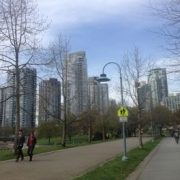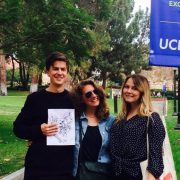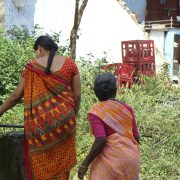Reformatory to Residential: Adaptive Reuse Social Housing in Vancouver

Bill Briscall explains RainCity’s success in developing social housing in the shadow of new luxury apartments.
Post by Laura Krawczyk, MURP candidate ’15
As rents rise in Vancouver’s Downtown Eastside, there is a looming question of whether or not there will still be room for low-income residents in the neighborhood known as “Canada’s poorest postal code.” Known locally as DTES it is analogous to LA’s Skid Row with exceedingly high rates of poverty, drugs, and mental illness. Development pressure and gentrification in the area is visible, though, with new high-end restaurants and coffee shops adjacent to social housing projects and mom-and-pop stores. Our group was given the opportunity to discuss the issue with the nonprofit housing organizations The Bloom Group and RainCity Housing, who work closely with the local government to secure homes accessible to individuals at all levels.
The 250 Powell social housing complex is one such example, a poetic reclamation of a former jail that is being converted to serve as housing for at-risk aboriginal youth. The 96-unit adaptive reuse project will be a mixed-income community, with social units cross-subsidized by low-end market units. The monolithic 1973 former remand center used to hold prisoners awaiting trial, but has been vacant for two decades, despite an operating juvenile court facility on the ground floor.

250 Powell: the former jail will soon serve as 96 units of mixed-income housing for first nation youth.
I see two key lessons for LA:
- Adaptive reuse of government buildings. It’s estimated the US government has nearly 1,000 vacant or underutilized buildings in California. Although we may not be reducing our prison population any time soon, the stock also includes office towers, warehouses, and operations buildings. As the government continues to right size and dispose of unused buildings, it’s essential the municipalities prioritize equitable uses for these spaces, with first right of refusal going to community uses or affordable housing.
- Context- and cultural-sensitive design. The Bloom Group worked closely with First Nations nonprofit organization BladeRunners to determine culturally-specific needs of the residents and community. This in turn informed both the programming and the design of the building, including a sound-proof dance studio for ceremonial purposes and prominent connections to outdoor spaces. Los Angeles is a melting pot of diverse backgrounds, and culturally-sensitive design can play a role in reaffirming sense of place as well as alleviating disparities among minority and immigrant populations
As Vancouver’s DTES is challenged with meeting the needs of both low-income residents and an influx of new higher-income businesses and residents, 250 Powell St. demonstrates the ability to harmoniously balance past with present. Perhaps DTLA can adopt these innovative strategies as well.









